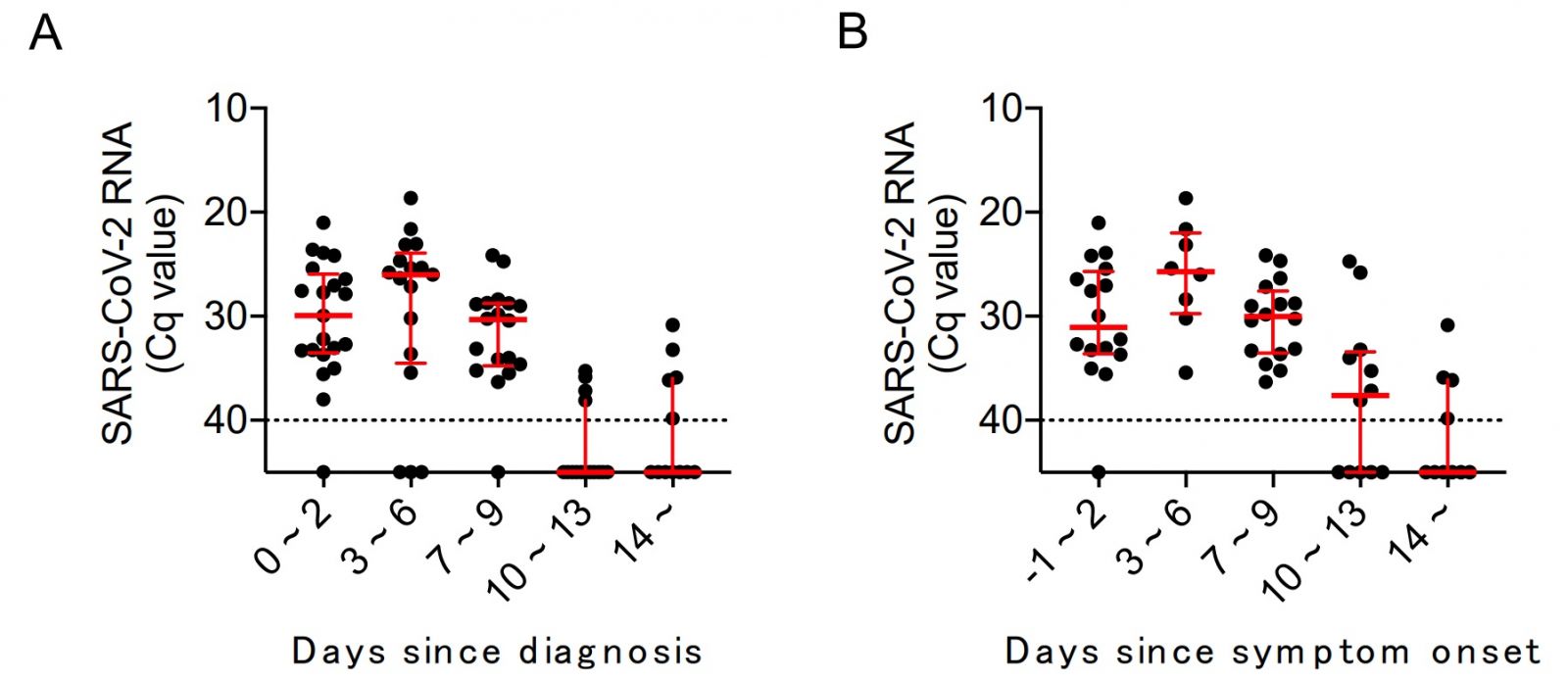BREAKING! Japanese Data Shows That Unlike Other SARS-CoV-2 Variants, Peak Of Viral Shedding Is Later With Omicron!
Source: Omicron Research Jan 16, 2022 3 years, 11 months, 1 week, 19 hours, 51 minutes ago
Omicron Research: Preliminary clinical observational data from the Japan’s National Institute of Infectious Diseases which conducts disease surveillance in Japan has found that the amount of Omicron viral RNA is highest three to six days after diagnosis or symptom onset.
https://www.niid.go.jp/niid/en/2019-ncov-e/10884-covid19-66-en.html
This new alarming data that confirms that patients with the omicron variant of COVID-19 shed virus for longer after symptoms emerge, potentially jeopardizes hopes that the period of isolation for individuals testing positive could be shortened.

It also questions the U.S.CDC’s new isolation and quarantine guidelines that were also adopted by many stupid countries!
The Japanese researchers from the National Institute of Infectious Diseases examined the duration of infectious virus shedding in Omicron cases identified early in this investigation.
A total of 83 respiratory specimens from 21 cases (19 vaccinees and 2 unvaccinated cases; 4 asymptomatic and 17 mild cases) were subjected to SARS-CoV-2 RNA quantification using quantitative reverse transcriptase polymerase chain reaction and virus isolation tests. The date of specimen collection for diagnosis or symptom onset was defined as day 0. The amount of viral RNA was highest on 3-6 days after diagnosis or 3-6 days after symptom onset, and then gradually decreased over time, with a marked decrease after 10 days since diagnosis or symptom onset. The positive virus isolation results showed a similar trend as the viral RNA amount, and no infectious virus in the respiratory samples was detected after 10 days since diagnosis or symptom onset.
These
Omicron Research findings also suggest that vaccinated Omicron cases are unlikely to shed infectious virus 10 days after diagnosis or symptom onset.
In England, the isolation period for individuals testing positive for COVID-19 was recently cut from 10 days to seven if two lateral flow tests returned negative results on days six and seven. Similar cuts to isolation have followed in Scotland, Wales, and Northern Ireland.
Essential workers getting sick and not reporting to work and staff absences elsewhere because of isolation have caused severe workforce shortages for critical services, including the NHS, schools, and transport, leading to calls for the UK to follow the US and cut the isolation period to five days.
Dr Paul Hunter, a professor in medicine at the University of East Anglia, one of the proponents of shortening isolation, , said that the latest Japanese data “muddy the waters.”
He said, “I’m still working my way through the evidence for and against given that the Japanese study has now shifted the balance.”
Past studies suggest that the peak transmission period for people with other variants was between two days before symptoms emerged and three days afterward, with virus shedding peaking on or before symptom onset.
https://pubm
ed.ncbi.nlm.nih.gov/32296168/
But the Japanese study suggests that with omicron, the peak of virus shedding may be two or three days later.
 Kinetics of viral RNA amount in respiratory samples obtained from Omicron variant infected cases
(A and B) Quantitative reverse transcriptase polymerase chain reaction (RT-qPCR) done at NIID for all respiratory samples received using NIID-N2 primer/probe set for cases of SARS-CoV-2 Omicron variant infection. The levels of viral RNA by (A) days since diagnosis or (B) days since symptom onset. Red bars indicate median Cq value with interquartile range. Dotted line indicates a cutoff value.
Kinetics of viral RNA amount in respiratory samples obtained from Omicron variant infected cases
(A and B) Quantitative reverse transcriptase polymerase chain reaction (RT-qPCR) done at NIID for all respiratory samples received using NIID-N2 primer/probe set for cases of SARS-CoV-2 Omicron variant infection. The levels of viral RNA by (A) days since diagnosis or (B) days since symptom onset. Red bars indicate median Cq value with interquartile range. Dotted line indicates a cutoff value.
It was reported that in Japan, individuals infected with SARS-CoV-2 are admitted to hospital under the Infectious Diseases Control Law or the Quarantine Act and released only after two consecutive negative tests by nucleic acid amplification or antigen quantification methods.
Increasing concerns that these discharge criteria may lead to prolonged hospital stays led the National Institute of Infectious Diseases to examine the duration of virus shedding to determine the period of potential infectiousness for patients with omicron.
Detailed quantification of SARS-CoV-2 RNA in 83 respiratory specimens from 21 cases using quantitative reverse transcriptase polymerase chain reaction and virus isolation tests revealed that the amount of viral RNA was highest three to six days after diagnosis or symptom onset, and then gradually decreased.
Alarmingly a similar trend was seen for positive virus detected in respiratory samples, with no infectious virus detected in samples after 10 days since diagnosis or symptom onset.
Dr Hunter added, “One factor in favor of shortening the isolation period is that testing is “missing” about two thirds of infections anyway!”
In the past, just under half of COVID-19 cases were detected by testing, but since omicron emerged this figure had dropped to under a third, he added.
Dr Hunter added that because many individuals have been exposed to omicron and it is circulating widely, isolation becomes less effective as a tool.
He added, “It will have some value for individuals in healthcare settings who are managing really ill people, but we’re getting to the point probably soon, if we’re not there already where the value will be less.”
Many Asian countries are refusing to follow the American and British isolation guidelines and this new Japanese study findings will also assist in them imposing more stringent guidelines unlike the crazy “Wild Wild West!”
For the latest
Omicron Research, keep on logging to Thailand Medical News.

